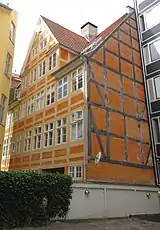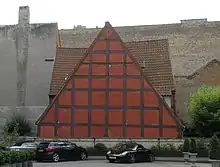Amaliegade 11
Amaliegade 11 is a former 18th century town house in the Frederiksstaden neighborhood of central Copenhagen, Denmark. The house was originally constructed in the mid-1750s with a facade design by Niels Eigtved in accordance with his overall guidelines for buildings in the new district. In the 1870s, it was acquired by silversmith Vilhelm Christesen and heightened to four storeys. On its rear is a succession of three free-standing secondary buildings separated by small courtyards. The building fronting the street and the two first rear wings, both of which are half-timbered, were listed in the Danish registry of protected buildings and places in 1978. Other notable former residents include two later admirals and a foreign minister.
| Amaliegade 11 | |
|---|---|
_01.jpg.webp) | |

| |
| General information | |
| Location | Copenhagen |
| Country | Denmark |
| Coordinates | 55°40′58.01″N 12°35′31.02″E |
| Completed | 1755 |
| Renovated | 1870s |
| Design and construction | |
| Architect | Nicolai Eigtved |
History
18th century
When Frederiksstaden was founded in 1750, it was initially envisioned as a district for the nobility and the city's most wealthy merchants. It soon proved difficult to sell the lots and some of them were therefore sold to well-to-do craftsmen. Jan Jansen, a cooper, purchased a long narrow lot at the site. He started out by constructing two half-timbered secondary buildings on the central part of his new property in 1753. In 1854–55, they were followed by a more elegant building vfronting the street. The facade was like many of the other houses from the same years in the street designed by the architect Nicolai Eigtved. Eigtved had also created the masterplan for the new district. On the rear of Jensen's property was a small garden.[1] The property is on Christian Gede's district map of St. Ann's East Quarter marked as No. 312.
19th century
.jpg.webp)
The property was in the new cadastre of 1806 listed as St. Ann's Quarter, No. 154. It had by then been acquired by the naval officer Peter Johan Wleugel (1766–1835).[2] During the Battle of Copenhagen, in August 1807, he served as commander of the brig Mercurius which was stationed at Kalbebod Beach. He reached the rank of counter admiral in 1833.[3]
Holger Christian Reedtz (1800-1857), who then served as secretary of the Department of Foreign Affairs, resided in the building from 1832 to 1835.[4]
No. 154 was at the time of the 1740 census home to a total of 66 people. The Actress at the Royal Danish Theatre Nathalia Ryge was in 1840 in the ground floor apartment.[5]
Carl Edouard van Dockum (1804-1893), a naval officer, was among the residents in 1845–46.[4] He had just returned to Copenhagen after serving as commander of the brig Najaden on a voyage to New York City and moved when he was appointed as head of the Naval Cadet Academy.[6]

The silver smith and manufacturer Vilhelm Christesen was from 1858 based in the first of the three rear wings. He resided withhis family in the apartment on the second floor. His silver workshop occupied the two lower floors while the attic housed the gold workshop. In 1878, he was able to purchase the entire property. From then on the family resided in the more prestigious apartment on the first floor of the front wing. He heightened the building to four storeys. Water and gas was also installed in all apartments. The basement of the building fronting the street was converted into a commercial space with a residential apartment for the tenant on its rear. The premises were over the next years mainly operated as a tavern.
Christesen's firm was especially remowned for its 'Ancient Norse' style jewellery, copying archeological objects, form the Bronze Age to the medieval period. The company's work was popular in England where it was copied by læcal goldsmiths.[7] Christesen died in 1899 and is buried in the Cemetery of Holmen.
20th century
A restaurant named Teatercaféen, literally "The Teatre Café", was in the 1930s based in the basement. Its name was inspired by Casino Teatret on the orher side of the street.[8]
Vilh. Søborg's Efterfølger, a printing business, was from 1845 based in the building. It had until then been based at Stormgade 6.[9]
Albert Madsen's Eftf, a retailer of furnishings and fittings for ships, was in 1072 based in the basement. The company had until then been based at Havnegade 51. [10]
Architecture
_02.jpg.webp)
Amaliegade 11 was originally constructed with a facade designed by Nicolai Eigtved in accordance with his own guidelines for the Frederiksstaden district. The mezzanine was in connection with Christesen's expansion in the 1870s replaced by a full third and fourth storey. The building is constructed in brick and stands on a granite plinth. It is rendered in a red colour with sandstone details. The five-bays wide building has a slightly projecting median risalit and the wide outer bays are flanked by lesenes. The cartouche above the gate dates from the construction of the building and features a barrel and a tub as a reference to the first owner's trade. The facade is finished by a dentilized cornice. The roof is clad with black tiles and features four arched dormer windows. A door in the gateway provides access to the building's principal staircase.[1]

The first of the three rear wings (1753) is a yellow-washed free-standing building, eight bays wide, consisting of consists of three storeys and a red tile roof with a three-astorey, through-going gabled wall dormer over the four central bays. The roof is penetrated by a central chimney. A roof terrace has been created on each side of the chimney in modern time. The front side of the ground storey has been rebuilt in brick whereas its reart side is still constructed with timber framing. A two-bay passageway in the sixth and seventh bay of the building provides access to the second courtyard. A door in the passageway provides access to the building's main staircase.[1]

The second rear wing (No. 11B, 1753) is red-wahed with brown-painted timber framing. It consists of two storeys and a roof with a three-storey gabled wall dormer. It is eight bays wide towards the second courtyard and nine bays wide towards the third courtyard. The roof is clad with red tiles and is penetrated by a large chimney.[1]
The building fronting the street (No. 11) and the two first rear wings (No. 11A and No. 11B) were listed in the Danish registry of protected buildings and places in 1978. The last of the three rear wings is not part of the heritage listing.[1]
Today
The property has been converted into condominiums. The property is jointly owned by the owners of the individual condominiums through E/F Amaliegade 11. The two condominiums in Amaliegade 11B were in 2019 owned by DR journalist Nina Munch-Perrin and media personality Bubber.[11]
References
- "Sag: Amaliegade 11". Kulturstgyrelsen (in Danish). Retrieved 8 January 2021.
- "Københavnske Jævnførelsesregistre 1689-2008" (in Danish). Selskabet for Københavns Historie. Retrieved 1 January 2021.
- Jens Schanche Vleugel. "Siegten Vleugel (Wleugel) i Danmark 1675—1862" (PDF). Personalhistorisk Tidsskrift (in Danish). Retrieved 1 January 2021.
- "Amaliegade 11-11a-d". indenforvoldene.dk (in Danish). Retrieved 8 January 2021.
- "Folketælling -1840 - Natalia Ryge". danishfamilysearch.dk (in Danish). Retrieved 28 January 2021.
- "C. van Dockum". Dansk Biografisk Leksikon (in Danish). Retrieved 8 January 2021.
- "Vilhelm Christesen". British Museum. Retrieved 8 January 2021.
- "Værtshus- og restaurationsnavne 1930-1964". Copenhagen Central Library (in Danish). Retrieved 7 January 2021.
- "Vilh. Søborg's Eftf. A/S". coneliand.dk (in Danish). Retrieved 7 January 2021.
- "Albert Madsen's Eftf., Aage Buck". coneliand.dk (in Danish). Retrieved 7 January 2021.
- "Nina Munch-Perrin sælger boligdrøm". Se og Hør (in Danish). Retrieved 8 January 2021.
Further reading
- Erichsen, John:Frederiksstaden. Grundlæggelsen af en københavnsk bydel 1749-1760. . 1972.
- Historiske huse i det gamle København. Nationalmuseet. 1972 (p. 18).
- Langberg. Harald: Hvem byggede hvad. Red. . Politikens Forlag. 2dn edition. 1968 (volu. I, p. 28).
- Kayser, Kjeld: Københavnerbindingsværk. Nationalmuseets Købstadsundersøgelser. 1985 (p.70, 83 og 298).
- Minderige huse – kendte mænd og kvinders boliger. Kraks Forlag. 1922.
External links
| Wikimedia Commons has media related to Amaliegade 11. |